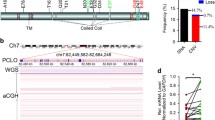Abstract
In recent decades, the multi-functional protein nucleolin (NCL) has been reported to express outside the nucleus of many cancer cells. However, the expression and role of the extra-nuclear NCL in esophageal squamous cell carcinoma (ESCC) were not well characterized. Here, NCL was detected by immunohistochemistry and Western blotting in 60 ESCC tissues. Further, the associations of NCL, EGFR, CXCR4 and Ki67 were analyzed by in vitro assays. Our results showed that NCL expression in all 40 cases of ESCC tissues with metastasis was extensively located in the nucleus, cytoplasm and cell membrane (extra-nucleus), while NCL expression in all 20 cases of ESCC without metastasis was merely limited into the nucleus (intra-nucleus).The extra-nuclear NCL expression was positively correlated with the expression of EGFR, CXCR4 and Ki67 and serves as an independent prognostic factor for ESCC patients. In vitro, NCL siRNA (si-NCL) efficaciously affected the expression of EGF or SDF-1-induced p-AKT, p-ERK and Ki67. Also, NCL siRNA inhibited the capacity of migration and invasion of ECA109 cells. In conclusions, our study suggests that NCL is implicated in the initiation and transduction of EGFR and CXCR4 signaling and further up-regulates Ki67 expression to modulate the biological behaviors of ESCC. Clinically, the extra-nuclear NCL expression can be used as an important indicator to determine metastasis and predict the prognosis, which help develop new therapeutic strategies against ESCC.



Similar content being viewed by others
References
Jemal A, Siegel R, Xu J, et al. Cancer statistics, 2010. CA Cancer J Clin. 2010;60:277–300.
Hongo M, Nagasaki Y, Shoji T. Epidemiology of esophageal cancer: orient to occident. Effects of chronology, geography and ethnicity. J Gastroenterol Hepatol. 2009;24:729–35.
Tepper J, Krasna MJ, Niedzwiecki D, et al. Phase III trial of trimodality therapy with cisplatin, fluorouracil, radiotherapy, and surgery compared with surgery alone for esophageal cancer: CALGB 9781. J Clin Oncol. 2008;26:1086–92.
Enzinger PC, Mayer RJ. Esophageal cancer. N Engl J Med. 2003;349:2241–52.
Hoshino M, Fukui H, Ono Y, et al. Nuclear expression of phosphorylated EGFR is associated with poor prognosis of patients with esophageal squamous cell carcinoma. Pathobiology. 2007;74:15–21.
Shi H, Huang Y, Zhou H, et al. Nucleolin is a receptor that mediates antiangiogenic and antitumor activity of endostatin. Blood. 2007;110:2899–906.
Abdelmohsen K, Gorospe M. RNA-binding protein nucleolin in disease. RNA Biol. 2012;9(6):799–808.
Mongelard F, Bouvet P. AS-1411, a guanosine-rich oligonucleotide aptamer targeting nucleolin for the potential treatment of cancer, including acute myeloid leukemia. Curr Opin Mol Ther. 2010;12:107–14.
Storck S, Shukla M, Dimitrov S, et al. Functions of the histone chaperone nucleolin in diseases. Subcell Biochem. 2007;41:125–44.
Kanwar JR, Roy K, Kanwar RK. Chimeric aptamers in cancer cell-targeted drug delivery. Crit Rev Biochem Mol Biol. 2011;46:459–77.
Hovanessian AG, Soundaramourty C, El Khoury D, et al. Surface expressed nucleolin is constantly induced in tumor cells to mediate calcium-dependent ligand internalization. PLoS One. 2010;5:e15787.
Birmpas C, Briand JP, Courty J, et al. The pseudopeptide HB-19 binds to cell surface nucleolin and inhibits angiogenesis. Vasc Cell. 2012;4:21.
Destouches D, Page N, Hamma-Kourbali Y, et al. A simple approach to cancer therapy afforded by multivalent pseudopeptides that target cell-surface nucleoproteins. Cancer Res. 2011;71:3296–305.
Krust B, El Khoury D, Nondier I, et al. Targeting surface nucleolin with multivalent HB-19 and related Nucant pseudopeptides results in distinct inhibitory mechanisms depending on the malignant tumor cell type. BMC Cancer. 2011;11:333.
Destouches D, El Khoury D, Hamma-Kourbali Y, et al. Suppression of tumor growth and angiogenesis by a specific antagonist of the cell-surface expressed nucleolin. PLoS One. 2008;3:e2518.
Otake Y, Soundararajan S, Sengupta TK, et al. Overexpression of nucleolin in chronic lymphocytic leukemia cells induces stabilization of bcl2 mRNA. Blood. 2007;109:3069–75.
Zhiqiang Xu, Joshi Neel, Agarwal Ashima. Knocking down nucleolin expression in gliomas inhibits tumor growth and induces cell cycle arrest. J Neurooncol. 2012;108:59–67.
Losfeld ME, Khoury DE, Mariot P, et al. The cell surface expressed nucleolin is a glycoprotein that triggers calcium entry into mammalian cells. Exp Cell Res. 2009;315:357–69.
Nisole S, Said EA, Mische C, et al. The anti-HIV pentameric pseudopeptide HB-19 binds the C-terminal end of nucleolin and prevents anchorage of virus particles in the plasma membrane of target cells. J Biol Chem. 2002;277:20877–86.
Nisole S, Krust B, Callebaut C, et al. The anti-HIV pseudopeptide HB-19 forms a complex with the cell-surface-expressed nucleolin independent of heparan sulfate proteoglycans. J Biol Chem. 1999;274:27875–84.
Acknowledgments
We greatly thank other members in our laboratory for valuable suggestions and writing.
Conflict of interest
None.
Author information
Authors and Affiliations
Corresponding author
Additional information
Jiafeng Qi, Huiling Li and Nanbo Liu have contributed equally to this work as the co-first author.
Rights and permissions
About this article
Cite this article
Qi, J., Li, H., Liu, N. et al. The implications and mechanisms of the extra-nuclear nucleolin in the esophageal squamous cell carcinomas. Med Oncol 32, 45 (2015). https://doi.org/10.1007/s12032-015-0484-3
Received:
Accepted:
Published:
DOI: https://doi.org/10.1007/s12032-015-0484-3




